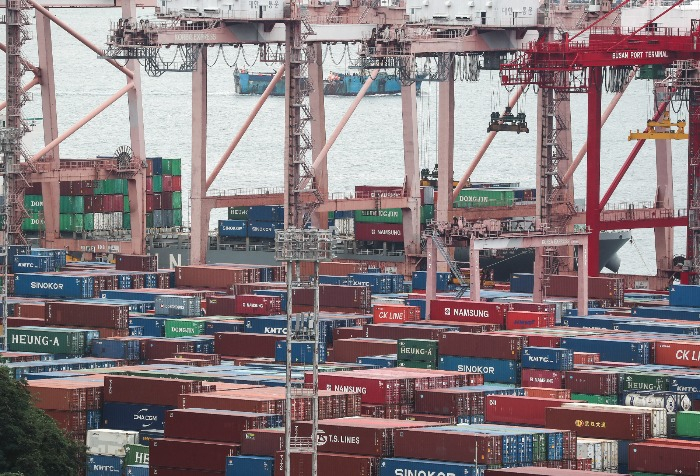Economy
S.KoreaŌĆÖs trade outlook dismal in Feb with stagnant exports
KoreaŌĆÖs trade deficit hit $17.6 billion from Jan. 1 to Feb. 10, already nearing 40% of its historic worst deficit last year
By Feb 13, 2023 (Gmt+09:00)
2
Min read
Most Read
S.Korea's LS Materials set to boost earnings ahead of IPO process


NPS to commit $1.1 billion to external managers in 2024


Samsung shifts to emergency mode with 6-day work week for executives


Samsung Heavy Industries succeeds autonomous vessel navigation


Korean battery maker SK On expects business turnaround in H2



South KoreaŌĆÖs trade deficit in just the first 40 days of this year inched close to 40% of its worst-ever annual deficit last year amid a continued fall of its mainstay export item semiconductors, and to its biggest trading partner China, raising concerns over the export-dependent countryŌĆÖs economy this year.
According to data from the countryŌĆÖs customs agency on Monday, exports from Feb. 1 to 10 reached $17.6 billion, up 11.9% from the same period a year earlier. Over the same period, imports grew 16.9% to $22.6 billion, resulting in a trade deficit of $4.9 billion.
Average daily exports over the same period, however, dropped 14.5%, with the number of working days up two days from last year to 8.5 days.
The cumulative trade deficit from Jan. 1 to Feb. 10 widened to $17.6 billion, already reaching 37% of last yearŌĆÖs total deficit of $47.2 billion, which had marked the worst-ever annual trade deficit for AsiaŌĆÖs fourth-largest economy since the agency started compiling data in 1965.
SLUGGISH CHIP EXPORTS, CHINA SLUMP
The countryŌĆÖs exports remained stagnant this month after extending their losing streak for the fourth month in a row in January, mainly due to a continued fall in outbound shipments of its mainstay export item semiconductors.
Chip exports from Feb. 1 to 10 contracted 40.7% on-year, spurring concerns that outbound shipments would stay in the red for seven straight months in February.
Shipments of petroleum products and automobiles, however, grew 28.8% and 166.8%, respectively, over the same period.
Exports to Korea's biggest trading partner China also declined 13.4% over the same period, while those to Taiwan and Hong Kong contracted 22.8% and 42.8%, respectively. Shipments to the US, the EU and Vietnam jumped 48.0%, 53.3% and 2.3%.
The total deficit in trade with China from Jan. 1 to Feb. 10 reached $156 million, with shipments to the Greater China region on a downward trend for the eighth month in a row in January.
RECESSION FEARS GROW
The latest trade data further fanned recession fears for the Korean economy, which relies heavily on exports, with no sign of an immediate recovery in global demand.
The Bank of Korea in November revised down its growth forecast for the countryŌĆÖs gross domestic product for 2023 to 1.7% from the previous projection of 2.1%, citing sluggish exports.
In the fourth quarter of 2022, the local economy contracted 0.4% on-quarter, its first decline in two and a half years.
The central bank will hold this yearŌĆÖs second monetary policy meeting on Feb. 23 to make a rate decision. It is widely expected to leave the rate unchanged at the current level of 3.5%, following┬Āa quarter percentage point hike in January,┬Āas data indicate a rapid cooldown in the countryŌĆÖs economy.
Write to Jin-gyu Kang at josep@hankyung.com
Sookyung Seo edited this article.
More to Read
-
 EconomyS.Korea likely to suffer recession as Jan exports tumble
EconomyS.Korea likely to suffer recession as Jan exports tumbleFeb 01, 2023 (Gmt+09:00)
3 Min read -

-

Comment 0
LOG IN


